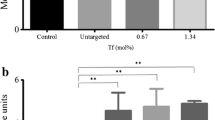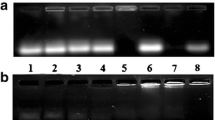Abstract
Delivery of small interfering RNA (siRNA) is recently gaining tremendous attention for the treatment of ovarian cancer. The present study investigated the potential of different liposomal formulations composed of (2,3-dioleoyloxy-propyl)-trimethylammonium (DOTAP) and 1,2-dioleoyl-sn-glycero-3-phosphoethanolamine (DOPE) encapsulating siRNA (hydration method) for their ability to knockdown luciferase (Luc) activity in human ovarian cancer SKOV-3 cells. Fluorescence single particle tracking (fSPT) and fluorescence correlation spectroscopy (FCS) in human-undiluted ascites fluid obtained from a peritoneal carcinomatosis patient revealed that cationic hydra-lipoplexes (HYDRA-LPXs) and HYDRA-LPXs decorated with stable DSPE-PEG (DSPE HYDRA-LPXs) showed high stability during at least 24 h. HYDRA-LPXs decorated with sheddable C8 and C16 PEG-Ceramides (Cer HYDRA-LPXs) resulted in rapid and premature release of siRNA already in the first hours. Despite their role in preventing aggregation in vivo, liposomes decorated with stable PEG residues resulted in a poor transfection compared to the ones decorated with sheddable PEG residues in reduced serum conditions. Yet, the transfection efficiency of both Cer HYDRA-LPXs significantly decreased following 1 h of incubation in ascites fluid due to a drastic drop in the cellular uptake, while DSPE HYDRA-LPXs are still taken up by cells, but too stable to induce efficient gene silencing.





Similar content being viewed by others
References
Lares MR, Rossi JJ, Ouellet DL. RNAi and small interfering RNAs in human disease therapeutic applications. Trends Biotechnol. 2010;28(11):570–9.
Wittrup A, Lieberman J. Knocking down disease: a progress report on siRNA therapeutics. Nat Rev Genet. 2015;16(9):543–52.
Dakwar GR et al. Colloidal stability of nano-sized particles in the peritoneal fluid: towards optimizing drug delivery systems for intraperitoneal therapy. Acta Biomater. 2014;10(7):2965–75.
Martens TF et al. Intracellular delivery of nanomaterials: how to catch endosomal escape in the act. Nano Today. 2014;9(3):344–64.
Kanasty R et al. Delivery materials for siRNA therapeutics. Nat Mater. 2013;12(11):967–77.
Chen CK et al. Poly(ethylene glycol)-block-cationic polylactide nanocomplexes of differing charge density for gene delivery. Biomaterials. 2013;34(37):9688–99.
Forbes DC, Peppas NA. Polycationic nanoparticles for siRNA delivery: comparing ARGET ATRP and UV-initiated formulations. ACS Nano. 2014;8(3):2908–17.
Jones CH et al. Overcoming nonviral Gene delivery barriers: perspective and future. Mol Pharm. 2013;10(11):4082–98.
Elouahabi A, Ruysschaert JM. Formation and intracellular trafficking of lipoplexes and polyplexes. Mol Ther. 2005;11(3):336–47.
Samal SK et al. Cationic polymers and their therapeutic potential. Chem Soc Rev. 2012;41(21):7147–94.
Wan C, Allen TM, Cullis PR. Lipid nanoparticle delivery systems for siRNA-based therapeutics. Drug Delivery and Translational Research. 2014;4(1):74–83.
Gomes-da-Silva LC et al. Lipid-based nanoparticles for siRNA delivery in cancer therapy: paradigms and challenges. Acc Chem Res. 2012;45(7):1163–71.
Mishra S, Webster P, Davis ME. PEGylation significantly affects cellular uptake and intracellular trafficking of non-viral gene delivery particles. Eur J Cell Biol. 2004;83(3):97–111.
Santel A et al. A novel siRNA-lipoplex technology for RNA interference in the mouse vascular endothelium. Gene Ther. 2006;13(16):1222–34.
Judge A et al. Hypersensitivity and loss of disease site targeting caused by antibody responses to PEGylated liposomes. Mol Ther. 2006;13(2):328–37.
Tagami T et al. Effect of siRNA in PEG-coated siRNA-lipoplex on anti-PEG IgM production. J Control Release. 2009;137(3–4):234–40.
Tagami T et al. Effect of siRNA in PEG-coated siRNA-lipoplex on the anti-PEG IgM production as induced by the PEG-coated siRNA-lipoplex. Mol Ther. 2009;17:S253.
Buyens K et al. Liposome based systems for systemic siRNA delivery: stability in blood sets the requirements for optimal carrier design. J Control Release. 2012;158(3):362–70.
Buyens K et al. A fast and sensitive method for measuring the integrity of siRNA-carrier complexes in full human serum. J Control Release. 2008;126(1):67–76.
Dakwar GR et al. Disregarded effect of biological fluids in siRNA delivery: human ascites fluid severely restricts cellular uptake of nanoparticles. ACS Appl Mater Interfaces. 2015;7(43):24322–9.
Ambegia E et al. Stabilized plasmid-lipid particles containing PEG-diacylglycerols exhibit extended circulation lifetimes and tumor selective gene expression. Biochimica Et Biophysica Acta-Biomembranes. 2005;1669(2):155–63.
Webb MS et al. Comparison of different hydrophobic anchors conjugated to poly(ethylene glycol): effects on the pharmacokinetics of liposomal vincristine. Biochimica Et Biophysica Acta-Biomembranes. 1998;1372(2):272–82.
Hunn J, Rodriguez GC. Ovarian cancer: etiology, risk factors, and epidemiology. Clin Obstet Gynecol. 2012;55(1):3–23.
Ceelen WP, Flessner MF. Intraperitoneal therapy for peritoneal tumors: biophysics and clinical evidence. Nature Reviews Clinical Oncology. 2010;7(2):108–15.
Zahedi P et al. An injectable depot system for sustained intraperitoneal chemotherapy of ovarian cancer results in favorable drug distribution at the whole body, peritoneal and intratumoral levels. J Control Release. 2012;158(3):379–85.
Dakwar GR, Shariati M, Willaert W, Ceelen W, De Smedt SC, Remaut K. Nanomedicine-based intraperitoneal therapy for the treatment of peritoneal carcinomatosis—mission possible? Adv Drug Deliv Rev. 2016. doi:10.1016/j.addr.2016.07.001.
George RD, Stefaan SCDS, Katrien R. Intraperitoneal nonviral nucleic acid delivery in the treatment of peritoneal cancer. In: Intraperitoneal cancer therapy. Boca Raton: CRC Press; 2015. p. 359–71.
Goldberg MS. siRNA delivery for the treatment of ovarian cancer. Methods. 2013;63(2):95–100.
Kim HJ et al. Recent progress in development of siRNA delivery vehicles for cancer therapy. Adv Drug Deliv Rev. 2016;104:61–77.
Lee SJ et al. Delivery strategies and potential targets for siRNA in major cancer types. Adv Drug Deliv Rev. 2016;104:2–15.
Creixell M, Peppas NA. Co-delivery of siRNA and therapeutic agents using nanocarriers to overcome cancer resistance. Nano Today. 2012;7(4):367–79.
Saraswathy M, Gong SQ. Recent developments in the co-delivery of siRNA and small molecule anticancer drugs for cancer treatment. Materials Today. 2014;17(6):298–306.
Wang J et al. Tumor priming enhances siRNA delivery and transfection in intraperitoneal tumors. J Control Release. 2014;178:79–85.
Bumcrot D et al. RNAi therapeutics: a potential new class of pharmaceutical drugs. Nat Chem Biol. 2006;2(12):711–9.
Buyens K et al. Elucidating the encapsulation of short interfering RNA in PEGylated cationic liposomes. Langmuir. 2009;25(9):4886–91.
Braeckmans K et al. Sizing Nanomatter in biological fluids by fluorescence single particle tracking. Nano Lett. 2010;10(11):4435–42.
Braeckmans K et al. Advanced fluorescence microscopy methods illuminate the transfection pathway of nucleic acid nanoparticles. J Control Release. 2010;148(1):69–74.
Li SD, Huang L. Stealth nanoparticles: high density but sheddable PEG is a key for tumor targeting. J Control Release. 2010;145(3):178–81.
Wheeler JJ et al. Stabilized plasmid-lipid particles: construction and characterization. Gene Ther. 1999;6(2):271–81.
Zhang YP et al. Stabilized plasmid-lipid particles for regional gene therapy: formulation and transfection properties. Gene Ther. 1999;6(8):1438–47.
Zuhorn IS et al. Nonbilayer phase of lipoplex-membrane mixture determines endosomal escape of genetic cargo and transfection efficiency. Mol Ther. 2005;11(5):801–10.
Shi FX et al. Interference of poly(ethylene glycol)-lipid analogues with cationic-lipid-mediated delivery of oligonucleotides; role of lipid exchangeability and non-lamellar transitions. Biochem J. 2002;366:333–41.
Betker JL, Gomez J, Anchordoquy TJ. The effects of lipoplex formulation variables on the protein corona and comparisons with in vitro transfection efficiency. J Control Release. 2013;171(3):261–8.
Acknowledgments
GD is a doctoral fellow of the Flemish Government (Vlaamse overheid). WC is a senior clinical investigator of the Fund for Scientific Research—Flanders (FWO). We thank Dr. Pieter Baatsen from KU Leuven for his help with the characterization of the formulations. This work was supported by the Research Foundation-Flanders (research project G006714N). We thank Senne Corneils for his help with the experiments.
Author information
Authors and Affiliations
Corresponding authors
Ethics declarations
Conflict of interest
The authors declare no conflict of interest.
Rights and permissions
About this article
Cite this article
Dakwar, G.R., Braeckmans, K., Ceelen, W. et al. Exploring the HYDRAtion method for loading siRNA on liposomes: the interplay between stability and biological activity in human undiluted ascites fluid. Drug Deliv. and Transl. Res. 7, 241–251 (2017). https://doi.org/10.1007/s13346-016-0329-4
Published:
Issue Date:
DOI: https://doi.org/10.1007/s13346-016-0329-4




